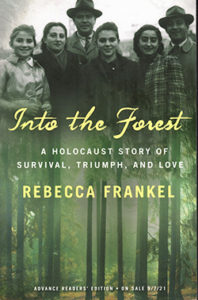Into the Forest: A Holocaust Story of Survival, Triumph and Love by Rebecca Frankel; St. Martin’s Press; (c) 2021; ISBN 9781350-267641; 355 pages plus author’s note; acknowledgment and end notes; $28.99
By Donald H. Harrison


SAN DIEGO — Meticulous research documents the lives of the Rabinowitz family in small town Poland; their suffering after the Nazis invaded; their miraculous escape to the forest, where they survived in hiding for several years; their post-war relocation to Italy, while awaiting permission to immigrate to Palestine; their decision to move instead to the United States; their lives in Connecticut; and the marriage of daughter Ruth to a future rabbi, from whom author Rebecca Frankel received her Jewish education.
This biography relies on scrupulous research, rather than sensationalism, to tell the story of what the Rabinowitz family endured during the Holocaust years. Family members were “selected,” taken away, shot, and buried in mass graves. They themselves hid underground in their small town of Zhetel, hearing the feet of Nazi searchers above them, and remaining in their suffocating hiding place until they could make their getaway to the forest.
The Nazis knew that Jews were hiding in the forest, so there were patrols and mass forays for the Rabinowitz family to elude, again through the device of underground shelters. The husband and wife and two young daughters learned what fruits and vegetables they could survive on, and from time to time, they were able to purchase other foods from a trusted Polish farmer, who advised them on the course of World War II.
The Russian Army drove the German Nazis out of the forest, liberating the Rabinowitzes and other Jewish families from their forest hideaways. At first, they returned to Zhetel, but nothing there remained for them, so they moved on to larger Polish cities like Lublin, and eventually with the help of the Zionist organization known as Bricha crossed borders to Austria and then to Italy, where they awaited transport to Palestine. However, when contact was made with relatives in the United States, that was chosen as a more practical option.
As one who has read many books about the Holocaust, what was new for me in this book was the story of the adjustment that Ruth (néeRochel) and her sister Toby (née) Tanya) made as teenagers after their arrival in the United States. They had to learn English and how to fit in with American girls who, thanks to geography, had been shielded from the European war and knew nothing of the kind of privation they had endured. Remarkably, the sisters were able to bridge that gap, one of them even being elected “Miss Congeniality” at a beauty pageant.
The biography comes full circle when Mrs. Rabinowitz receives a letter from Philip Lazowski, who had been outdoors without his family during a sudden roundup and selection by the Nazis. He didn’t know the Rabinowitz family, but pleaded with Mrs. Rabinowitz to claim him as her son so that if her family survived, so would he. She instantly agreed, and he never forgot his savior. Years after the war, he learned that she was living with her family in Connecticut and asked permission to visit. He didn’t know that Rochel, now Ruth, would be so enchanting, nor that she someday would become his wife and the rebbetzin at Beth Hillel Synagogue in Hartford, Connecticut.
*
Donald H. Harrison is editor of San Diego Jewish World. He may be contacted via donald.harrison@sdjewishworld.com